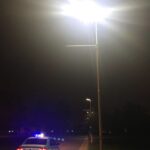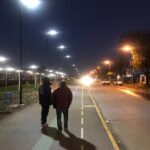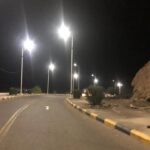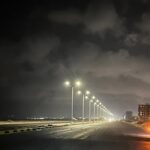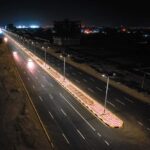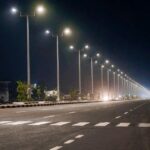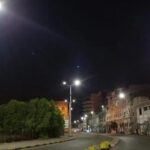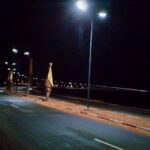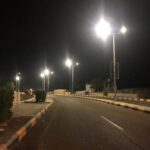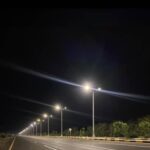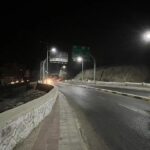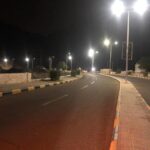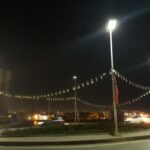Solar street lights play a vital role in illuminating our streets, ensuring safety, and enhancing the overall aesthetics of our cities. However, it is not uncommon to encounter instances where these lights cease to function properly. A solar street light not working creates a significant problem that needs immediate attention. Let’s explore the common reasons behind solar street lights not working and discuss potential troubleshooting methods to restore their efficient operation.

Vital components of a solar street light
A solar street light consists of several essential components that work together to harness solar energy and provide illumination. Here are the vital components of a typical solar street light:
- Solar Panel: The solar panel is responsible for converting sunlight into electrical energy. It consists of multiple photovoltaic (PV) cells that absorb solar radiation and generate direct current (DC) electricity.
- Battery: The battery stores the electrical energy generated by the solar panel during the day for use during the night. It ensures a continuous power supply to the street light and acts as an energy reserve.
- LED Light Fixture: Light Emitting Diode (LED) is the primary source of illumination in a solar street light. LED lights are energy-efficient, long-lasting, and capable of producing high-quality light with minimal power consumption.
- Controller: The controller manages the overall operation of the solar street light system. It regulates the charging and discharging of the battery, controls the lighting duration, and provides protection against overcharging and over-discharging.
- Pole and Mounting Structure: The pole provides structural support for the solar street light and holds the solar panel, battery, LED fixture, and other components. The mounting structure ensures secure installation of the street light on the pole.
- Sensor and Motion Detector (optional): Some solar street lights are equipped with sensors and motion detectors. These components detect changes in ambient light levels and movement, allowing the light to automatically adjust its brightness or activate when someone approaches.
- Wiring and Connectors: Wiring and connectors serve as the electrical connections between the solar panel, battery, LED fixture, and controller. Proper wiring ensures efficient energy transfer and reliable functioning of the street light system.
Components that can cause a solar street light not working crisis.
Solar Street Light Not Working; Common Issues
What causes a solar street light not working situation?
- Insufficient sunlight: Solar street lights rely on sunlight to charge their batteries and power the light. If the light is located in an area with limited direct sunlight exposure, such as under dense tree cover or in a shaded area, it may not receive enough sunlight to charge properly.
- Battery issues: The solar street light system consists of a battery that stores energy during the day for use at night. If the battery is old, damaged, or not properly connected, it may fail to store enough energy or provide power to the light.
- Faulty solar panel: The solar panel is responsible for converting sunlight into electricity. If the solar panel is damaged, dirty, or not positioned correctly, it may not generate enough electricity to power the light or charge the battery effectively.
- Controller malfunction: The controller regulates the charging and discharging of the battery and controls the light operation. A faulty or damaged controller can prevent the light from functioning properly.
- Wiring issues: Poorly connected or damaged wiring can disrupt the flow of electricity within the solar street light system. Loose connections, corroded wires, or damaged cables can prevent the light from working.
- Component failure: Various components of the solar street light, such as the LED bulb, photocell, or motion sensor, may experience failure due to wear and tear, electrical issues, or environmental factors.
Solar Street Light Not Working Fixes
A solar street light not working situation can be resolved in multiple ways. Let’s discuss the common fixes.
1. Check the solar panel connection
Carefully examine the wiring between the solar panel and the street light system. Ensure that all the cables are securely connected, without any visible fraying or damage. Make sure that the connectors are properly seated and tightened to maintain a solid electrical connection.
After confirming the physical integrity of the connections, move on to inspecting the wiring terminals. If applicable, check the terminal box or junction box where the solar panel wires connect to the street light system. Open the box and inspect the connections inside. Look for any loose wires or signs of corrosion, which could impede the electrical flow.
If you find any loose connections or damaged wiring during your inspection, it is important to rectify them promptly. Secure any loose connections by tightening them appropriately and replace any damaged wiring or connectors as needed. Additionally, clean any corrosion from the terminals using a suitable electrical contact cleaner. Any issue with your solar panel connection can cause a solar street light not working situation.
2. Verify battery condition
Once the connections are confirmed, proceed to examine the battery itself. Begin by turning off the solar street light and disconnecting it from any power source. Carefully remove the battery from its compartment, following the manufacturer’s instructions if available. Inspect the battery for any visible signs of damage, leakage, or corrosion. Any compromised or faulty battery can cause a solar street light not working situation.
If the battery appears to be in good condition externally, measure its voltage using a multimeter or voltmeter. A healthy solar street light battery should have a voltage reading within the manufacturer’s specified range. If the voltage is below the recommended level, the battery might need recharging or replacement.
In case the battery voltage is within the acceptable range, consider performing a discharge test. Connect the battery to a suitable load and monitor its performance over time. If the battery fails to hold a charge or shows rapid voltage drop, it indicates a potential issue. It may be necessary to replace the battery even if it initially appeared to be in good condition.
3. Test the Led Bulb
Once you have gained access to the LED bulb, visually inspect it for any visible signs of damage or malfunction. Look for broken wires, loose connections, or any signs of burning or discoloration. If you notice any issues, it is likely that the LED bulb needs to be replaced.
To verify whether the LED bulb is the cause of the solar street light not working situation, you can perform a simple test. Replace the existing bulb with a known working LED bulb of the same specifications. Ensure that the replacement bulb is compatible with the solar street light system to avoid any compatibility issues. After installing the replacement bulb, reconnect any wires or connectors that were disconnected earlier, making sure they are securely fastened.
Finally, test the solar street light by turning it on. If the light illuminates and functions properly with the new LED bulb, it indicates that the previous bulb was indeed the source of the problem. However, if the light still does not work or exhibits the same issues, further troubleshooting may be required to identify the underlying cause.
4. Examine the light sensor
Inspect the sensor for any visible signs of damage, such as cracks, loose connections, or corrosion. These physical defects can impair the sensor’s ability to accurately detect light levels, resulting in a solar street light not working situation. Next, ensure that the sensor is clean and free from any dirt, dust, or debris that might be obstructing its operation. Use a soft cloth or a gentle brush to carefully clean the sensor surface.
Once the sensor is clean, check its wiring connections. Make sure the wires are securely connected to the sensor and that there are no loose or frayed ends. Loose connections can disrupt the communication between the sensor and the control system, leading to a malfunctioning street light.
If the sensor appears undamaged, clean, and properly connected, it is advisable to test its functionality. Cover the sensor with a dark cloth or shield it from direct light sources and observe the behavior of the street light. It should turn on automatically as it detects the decreased light levels. Remove the obstruction or expose the sensor to natural light, and the street light should turn off accordingly. If the street light fails to respond as expected, it indicates a potential issue with the sensor.
5. Inspect the controller
Ensure that the charge controller is securely connected to the solar panel, battery, and light fixture. Inspect the wiring connections for any signs of wear or improper connections. Loose or disconnected wires can disrupt the flow of electricity and cause a solar street light not working situation.
After confirming the physical connections, proceed to examine the controller’s settings. Depending on the specific model and design, the controller may have various settings related to light operation, timing, and dimming functions. Make sure that the settings are correctly configured according to the desired operational requirements. Adjustments may be necessary if the street light is not turning on or is not functioning as intended.
In addition to visual inspection and settings, it is essential to check the controller’s documentation or consult the manufacturer’s guidelines. These resources can provide specific troubleshooting steps, error codes, or diagnostic tools to help identify and resolve issues related to the controller.
Conclusion
When confronted with a solar street light not working crisis, it is crucial to take prompt action and address the issue. Remember, if you are uncertain about any step or lack the necessary expertise, it is advisable to seek professional assistance or consult the manufacturer’s instructions. Safety and proper handling of electrical components should always be a priority when troubleshooting and maintaining solar street lights.



